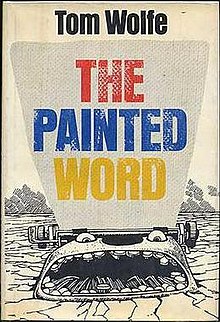The Painted Word

First edition
|
|
| Author | Tom Wolfe |
|---|---|
| Country | United States |
| Language | English |
| Genre | Art criticism |
| Publisher | Farrar, Straus & Giroux |
|
Publication date
|
1975 |
| Media type | |
| Pages | 153 |
| ISBN | |
| OCLC | 39164533 |
The Painted Word is a 1975 book of art criticism by Tom Wolfe.
By the 1970s Wolfe was, according to Douglas Davis of Newsweek magazine "more of a celebrity than the celebrities he describes." The success of Wolfe's previous books, in particular The Electric Kool-Aid Acid Test in 1968 and Radical Chic & Mau-Mauing the Flak Catchers in 1970, had given Wolfe carte blanche from his publisher to pursue any topic he desired. In the midst of working on stories about the space program for Rolling Stone—stories that would eventually grow into the 1979 book The Right Stuff—Wolfe became interested in writing a book about modern art. As a journalist, Wolfe had devoted much of his writing career to pursuing realism; Wolfe read in Hilton Kramer's 1974 Times review of Seven Realists, that "to lack a persuasive theory is to lack something crucial". Wolfe summarized the review saying that it meant "without a theory to go with it, I can't see a painting".
Prior to publication in book form, The Painted Word was excerpted in Harper's Magazine. Wolfe's longtime publisher Farrar, Straus & Giroux released the book in 1975.
Wolfe's thesis in The Painted Word was that by the 1970s, modern art had moved away from being a visual experience, and more often was an illustration of art critics' theories. Wolfe criticized avant-garde art, Andy Warhol, Willem de Kooning and Jackson Pollock. The main target of Wolfe's book, however, was not so much the artists, as the critics. In particular, Wolfe criticized three prominent art critics whom he dubbed the kings of "Cultureburg": Clement Greenberg, Harold Rosenberg and Leo Steinberg. Wolfe argued that these three men were dominating the world of art with their theories and that, unlike the world of literature in which anyone can buy a book, the art world was controlled by an insular circle of rich collectors, museums and critics with outsized influence.
...
Wikipedia
